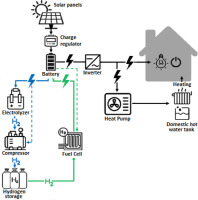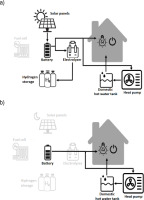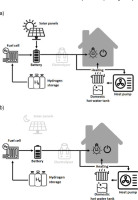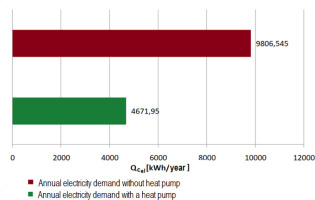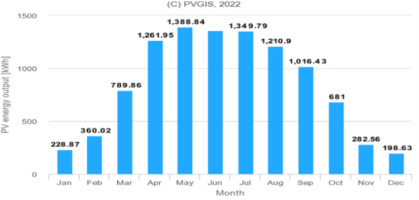INTRODUCTION
Popularization and increasing use of renewable power sources for distributed generation and increasing energy price, encourage to the production of electricity for private use. On the other hand, energy production with renewable energy sources depends on weather conditions. Photovoltaic and other solar systems depend on solar radiation and ambient temperature. Therefore, the same amount of energy cannot be provided at the all-time and other sources need to be found to provide electrical energy at the time when production with renewable energy is not possible, has made it the application of storage systems a necessity to ensure the continuous supply. In the building sector, this has led to growing interest in energy self-sufficient buildings that feature battery and other energy storage. Different techniques are today used to store both electric and thermal energy, making use of mechanical, electric, chemical, thermal and biological systems, the most widespread and versatile of which are presently batteries. Battery-electric systems are widely installed in residential buildings in order to increase self-consumption from PV. Advancements in battery technology seek to lower capacity costs and reduce environmental impacts. Another approach is to store energy in the form of hydrogen. Hydrogen is important as a large-quantity, long-term energy storage. Hydrogen storage has a very low rate of self-discharge and high energy density. Hydrogen is considered an excellent clean fuel with potential applications in many fields thus the hybridization of hydrogen and solar energy technologies is an interesting option to satisfy power in locations that are isolated from the electric grid as well as households. Hybrid system (photovoltaic-hydrogen) makes it possible of power hydrogen storage by means of an electrolyzer in pressurized tanks which and then converted into electricity in fuel cells when needed. Thus, electrolysis and hydrogen storage have been highly recommended for long-term alternatives for electricity storage [6]. A self-sufficient energy supply with hydrogen storage has already been realized for single- and multi-family dwellings, as well as for residential districts, and there are commercial suppliers that offer all-in-one hydrogen solutions for residential storage. Numerous hybrid systems based on renewable energy and H2 for building have been discussed in [2,3,5]. A combination of photo-voltaic systems and hydrogen fuel cells is shown to be able to provide complete self-sufficiency in electrical energy [4,5]. Paper [3] presents an analysis of energy production in a pilot building located in Slovenia, which is a typical residential house with an installed photovoltaic system and battery system for storage electricity. This study shows that complete self-sufficiency can be achieved by supplementing photovoltaic systems with hydrogen fuel cells. Whereas in paper [4] the comprehensive thermo-economic analysis is presented for a novel integrated solar hydrogen energy system for standalone operation. Authors in the work [1] described a methodology to design PV-H2 hybrid systems that considers the weather data and the electrical variables of the components to perform energy balances and to assess the system in terms of the load requirements, the levels of energy stored and the resulting costs. The work [6] presents the results of simulation of battery and hydrogen technologies for renewable energy management, load-levelling and peak-shaving in a single grid-connected house in Nottingham (United Kingdom) where three people live. A 10 kWh lead-acid battery and a 1 kW fuel cell together, with a 600 l hydrogen storage tank at 15 bar are used for these simulations for short (daily cycles) and mid-term (3-day cycles) storage, respectively. Showed that the battery increases the local use of PV energy generated on-site by 171%, while the hydrogen increases it by 159%. In the paper [7] shows a demonstration installation of the Hydro Q-BiC®, consisting of 64.75 kW photovoltaic (PV) panels, a 5 Nm3/h water electrolyzer, 40 Nm3 of metal hydride hydrogen storage, 14 kW fuel cells and 20 kWh Liion batteries, is discussed here. In all cases, the CO2 reduction capability is shown to be better than that of the PV-only system. Simulating annual CO2 emissions indicates that the Hydro QBiC® can reduce emissions by more than 50%.
We can safely say that a synergy between photovoltaic system and hydrogen fuel cells is a step forward to complete self-sufficiency with renewable energy sources, were by introducing fuel cells, electrical energy can be provided independently of the seasons and weather conditions.
A MICRO-POLIGENERATION SYSTEM FOR ZERO-ENERGY BUILDING
The polygeneration system is considered for a single-family house located in Gdańsk with an area of 80 m2, inhabited by 3 people with roof of the facing south. It was assumed that utility water and the house will be electrically heated.
The installation scheme and its components for the considered house is shown in Fig. 1. The installation consists of an electric power generation system endowed with photovoltaic panels, a charge regulator, an inverter, a battery pack, an electrolyzer for hydrogen production, a hydrogen compressor, hydrogen storage tanks, a fuel cell for production of electricity and a heat pump. An air heat pump was used to reduce electricity consumption for heating the house and domestic water.
The photovoltaic system consists of 26 monocrystalline photovoltaic panels with a power of 390 W and an efficiency of 20.6% each. The total power of photovoltaic panels is 10.14 kWp. For the generated power, an inverter from VOLT POLSKA was selected, which converts 24 V DC into 230 V and 50 Hz alternating current with 95% efficiency. An AGM battery with a capacity of 43 kWh and a voltage of 24 V was used to store electricity. The battery has 1800 charging cycles. To safely charge the battery, a Lumiax voltage regulator is used, which ensures the correct charging current and protects the battery against overcharging. The excess of electric current generated by photovoltaic panels is directed to the PEM electrolyzer manufactured by McPhy to convert electric energy into hydrogen chemical energy. The capacity of the electrolyzer is 1 – 1.6 Nm3/h, and the power is 6 – 9 kW. It is an electrolyzer that works well in small home hydrogen power plants. The hydrogen produced in the electrolyzer is compressed in a compressor to a pressure of 350 bar. Then, the compressed hydrogen is stored in 18 tanks manufactured by MAHYTEC with a capacity of 0.25 m3 at the pressure of 350 bar. In order to recover electricity from hydrogen, a Horizon PEM fuel cell with a power of 5 kW and an efficiency of 60% was used. In order to reduce electricity consumption for heating the building and domestic hot water, an air heat pump was used with the power of 4.6 kW with a COP 3.26 coefficient.
The system works in two modes, spring – summer and autumn – winter depending on the intensity of solar radiation.
First mode - short-term energy storage (spring-summer period). When the solar irradiation is higher than the electricity requirement of the house, excess electric power goes to the battery and electrolyzer, which generates hydrogen which after compressed goes to the storage tanks. When the solar irradiation is lower than the electricity requirement of the house or it is nighttime, the energy is drawn from the batteries. Thus, the batteries must have a capacity to meet the demand for electricity not only at night but also on a sunless day. Short-term energy storage for about 1 to 2 days can be most efficiently achieved with batteries with high energy conversion efficiency. Efficiency of storage and recovery energy for batteries is 85%. The diagram of the system operation in the spring-summer period is shown in Fig. 2.
Second mode - long-term energy storage (autumn–winter period). When the solar irradiation is permanently lower than the electricity requirement of the house, both during the day and at night the energy is simultaneously drawn from the batteries and the fuel cell which consumes previously stored hydrogen. The hydrogen storage should be large enough to provide energy for the entire autumn and winter period. Efficiency of storage and recovery energy for hydrogen is 35% (it is a total efficiency of energy conversion for an electrolyzer, a compressor and a fuel cell). The diagram of the system operation in the autumn–winter period is shown in Fig. 3.
Tab. 1 shows the efficiency and lifetime of the components of the polygeneration system.
CALCULATION AND RESULTS
Calculations for the energy demand of the house were made on the basis of our own energy measurements, the currently applicable standards and regulations as well as official statistical data from the Statistics Poland (GUS). Additionally, a PVGIS calculator was used to calculate and simulate photovoltaic energy (for Europe, Asia, Africa and South and North America). This application allows you to calculate the monthly and yearly potential electricity production of a PV system with a defined slope and orientation of the modules.
Household’s electricity demand
The demand for electricity was estimated on the basis of own measurements and data from the Statistics Poland (GUS). The average consumption of electricity in a household with an area of approximately 100 m2 is 2375 kWh per year, and is similar to the values obtained from own measurements where it was 2400 kWh per year.
Household’s energy demand for heating domestic hot water
The annual energy demand for heating domestic hot water was calculated in two ways, according to the method contained in the regulation of the Minister of Infrastructure of November 6, 2008 (equation 1).
where: QW,Nd1- annual utility energy demand for domestic hot water preparation [kWh], VCW,i - daily unit consumption of hot water at 55 °C depending on the type of building [dm3/(units per day)], Li - number of reference units - number of people living in the building [−], cw - specific heat of water [kJ/(kg K)], ρw - water density [kg/dm3], θw - hot water temperature in the tap [°C], θo - cold water temperature [°C], kt - correction factor [−], tuz - time of use, less holiday breaks, on average during the year by 10% [days], and according to the method described in the regulation of the Minister of Infrastructure of June 3, 2014 (equation 2). where: QW,Nd2 - annual utility energy demand for domestic hot water preparation [kWh], VW,i - daily unit demand for domestic hot water [dm3/(m2 day)], Af - area of rooms with regulated air temperature [m2], cw - specific heat of water [kJ/(kg K)], ρw - water density [kg/dm3], θw - hot water temperature in the tap [°C], θo - cold water temperature [°C], kR - correction factor for interruptions in the use of domestic hot water [−], tR - usage time [days].Thus, the demand for thermal energy to heat domestic hot water for a family of three living in a single-family building according to the Regulation of the Minister of Infrastructure of November 6, 2008 (equation 5.1), amounted to 1806.545 kWh per year, while according to the Ordinance of the Minister of Infrastructure of June 3, 2014 (equation 5.2), the following was obtained 2141.09 kWh per year. For further calculations, the value obtained from equation 5.1 was adopted, which is close to the actual values resulting from own operational measurements at home.
Household’s energy demand for heating house
The annual demand for thermal energy in the house results from the adopted rules (Standard WT 2021) that in newly constructed single-family houses, the value of the primary energy index should be no more than 70 kWh/m2 per year. Thus, the annual total energy requirement for the proposed house is 5600 kWh per year.
Household’s total energy demand
The annual total energy demand for a single-family energy-saving house with an area of 80 m2 was calculated from the dependence 3 and is:
where: QC - annual total energy demand of the building [kWh/year], QCO - annual energy demand to heat the building [kWh/year], QCWU - annual energy demand for heating domestic hot water [kWh/year], Qel - annual electricity demand [kWh/year].The use of a heat pump with a SCOP coefficient of 3.26 allows to reduce the demand for electricity for heating the building and domestic hot water to 1717.79 kWh (30.7% less energy in comparison to heating without heat pump) per year and 554.15 kWh (30.7% less energy in comparison to heating without heat pump) per year, respectively. Fig. 4 shows comparing annual electricity demand in cases where the heating of the building and domestic hot water is provided by an electrical installation or a heat pump.
In order to properly distribute energy, it was necessary to estimate the monthly energy demand for the house. Tab. 2 shows the monthly demand for thermal energy for house in Gdańsk and electricity for heat domestic water and other needs. To simplify the calculations, a constant monthly demand for electricity for water heating was assumed.
Tab. 2.
Electricity demand depending on the month
Photovoltaic installation
Based on the calculated demand for electricity, the power of the photovoltaic installation was estimated, taking into account the losses resulting from the aging of photovoltaic cells and energy conversion losses in the production and storage of hydrogen as well as loss related to the conversion of hydrogen to electricity in the fuel cell. In order for the designed system to meet certain assumptions, the total power of the modules should be 10.14 kWp. On this basis, a simulation was carried out in the PVGIS calculator, which determines the monthly production of electricity from the photovoltaic system located in Gdańsk. The results obtained for the photovoltaic installation are shown in Fig. 5.
Based on a simulation of a photovoltaic installation, knowing the monthly electricity demand of a household, it was determined that from March to October, the photovoltaic system produces more electricity than the recipients’ demand. In March, the system starts the process of producing and storing hydrogen. All electricity from the photovoltaic system is directed via the charge regulator to the battery. However, in January, February, November and December, the electricity from the photovoltaic system does not cover the household’s electricity needs, so during this time the photovoltaic installation is supported by the hydrogen system. Tab. 3 presents the calculations of energy conversion at individual stages of the system.
Tab. 3.
Results of calculations of energy conversion for a 10.14 kWp photovoltaic installation after 25 years of use for individual months
An example of the system operation in January is presented in Fig. 6.
Was calculate that the average electricity demand is 2400 kWh per year, the energy for domestic hot water is 1806 kWh per year and the energy for heating the building is 5600 kWh per year. The total energy demand for the house is 9806 kWh/year. The use of a heat pump reduces the energy requirement to 4672 kWh/year. Therefore to ensure the energy self-sufficiency of the building (both direct energy consumption and storage in the form of hydrogen), the power of photovoltaic panels should be 10.14 kWp. For solar energy available in Gdańsk, from the excess electricity of the PV system over 108 kgH2/year may be produced. The excess electricity from photovoltaics lasts from March, peaking in May, through October. The electrical energy efficiency of the hydrogen system equals 35.33%. Whereas, the electrical energy efficiency of the battery system equals 85%.
INVESTMENT COSTS
The investment costs of the devices included in the installation were estimated on the basis of the offer available on the market from January 2022 – Tab. 4. In addition, the amount obtained should include assembly costs, the cost of safety installations, fire and explosion-proof installations and elements such as cables, surge arresters, connectors and others. Using the literature [11], it was found that the cost of the system, taking into account the expenses for additional installations and elements, will increase by about 36.5%. Thus, the total value of the energy self-sufficient system is estimated at 300000 PLN. It is a preliminary concept, the assumption of which was to estimate the possibility of proposing such a system and the approximate investment costs.
Tab. 4.
Cost of devices used in the designed system (price from January 2022)
CONCLUSIONS
A solar hydrogen and electricity producing system along with their storage facilities are developed and investigated parametrically for residential use. Preliminary calculations of an integrated power generation system consisting of the PV modules, electrolyzer, compressor, hydrogen tanks, fuel cell, and battery and heat pump was conducted. In the proposed system, energy can be stored and consumed at required times from the battery and/or hydrogen storage tank. An important issue in the proposed system is the estimation of the daily and annual power demand for the building. For the solar energy available in Gdańsk, the excess electricity of the PV system produces over 108 kg hydrogen over one year. The electrical energy efficiency of the hydrogen system equals 35.33%. Whereas, the electrical energy efficiency of the battery system equals 85%. A hybrid system with photovoltaic system and hydrogen fuel cells can be a solution for complete self-sufficiency. Low-temperature PEM fuel cells are highly efficient energy conversion systems, as they convert the hydrogen energy directly into electricity without being subjected to the limitation of Carnot efficiency, The main advantages of using PEMFCs are their fast response to variable loads, rapid start-up, low operating temperature (60–100°C), high power density [8.] The investment is relatively expensive, because of the high cost of the elektrolyzer, hydrogen compressor, hydrogen storage tank and fuel cell and other component.

